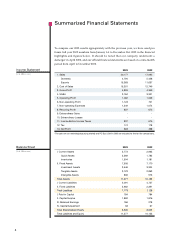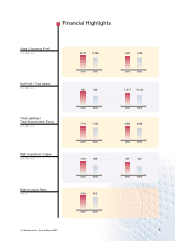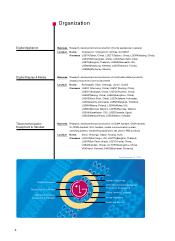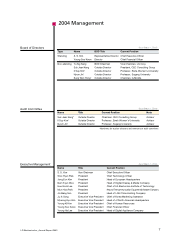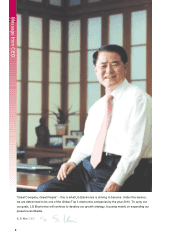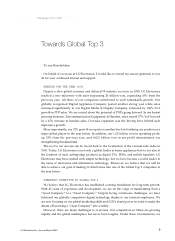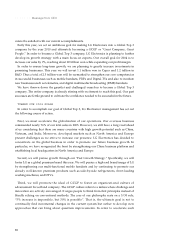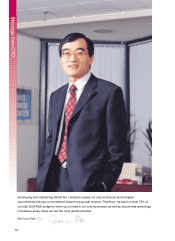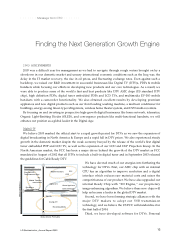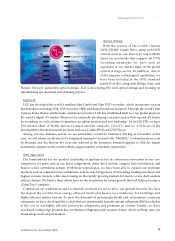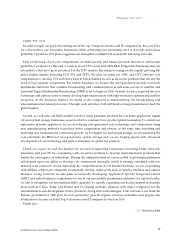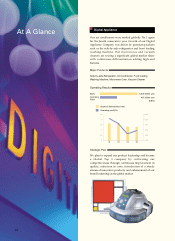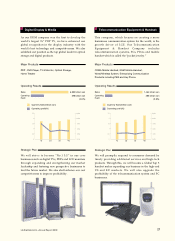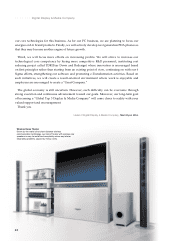LG 2003 Annual Report Download - page 14
Download and view the complete annual report
Please find page 14 of the 2003 LG annual report below. You can navigate through the pages in the report by either clicking on the pages listed below, or by using the keyword search tool below to find specific information within the annual report.
14
Video Recorders (PVRs) with easy-to-use record & playback functions are rapidly gaining market acceptance.
To serve this market we have released the world’s first 60” LCD Projection TV with an internal High
Definition (HD) PVR. Giving further evidence of our technological prowess is the development of our digital
Set-Top Boxes (STB) that support two-way Data service for Korea’s satellite servicing company, Skylife.
PDP
With the successful ramp up of our second PDP line, we now have a yearly production capacity of 780,000
units. Yield improvement and a new production process have helped us become the second largest PDP
module producer in the world. We are the first in the world to use etching technology on the PDP rear plate
in cooperation with LG Micron. This new technology helps to bring down costs faster than our competitors
while improving resolution. As the market demand for PDPs increases rapidly, we are determined to reach
our goal of becoming a Global Top company by 2005 through early stage investments, development of new
technologies for higher definition screens, and cost innovation.
OLED
The market for OLED technology as external displays for mobile handset has come earlier than expected.
We are in the process of developing a commercial production line, and our advancements in process and
production technologies put us on schedule to have a full-scale product release in 2004. Moreover, we are
developing an active matrix type OLED for a mobile handset’s main display. To keep up with this rapidly
growing market, we will use “Top Emission” methods to continuously improve yields and increase the
lifetime of the organic material.
Mobile Handset
The rise of multimedia service is an important trend for our CDMA business. Accordingly, we developed
the world’s first camcorder handset that can capture up to an hour’s worth of motion pictures. Our lineup
also now includes an M-Commerce handset that is capable of financial transactions and a GPS handset as
well. To target users in North America and China, we have shipped high-end camera handsets and
multimedia handsets. We achieved great success and confirmed our status as a technological leader as our
camera handset supplied to Verizon in North America was nominated by Business Week as the hit product of
the year. As for our GSM business, we have been raising our brand image by releasing high-end models such
as a slim-type dual folder handset and Multimedia Messaging Service (MMS) handsets with built-in camera
and OLED external display. On the back of these results, we were able to successfully enter the US GSM
market. To serve the IMT-2000 market, we commercialized a W-CDMA dual band dual mode handset that
can use existing CDMA infrastructure. We are gearing up for commercialized service in 2004 in Korea, and in
Europe we will be promoting sales to major carriers.
Mobile Communication System
Our equipment was used successfully by KTF to support Korea’s first asynchronous type of IMT-2000
service known as Universal Mobile Telecommunications Services (UMTS). We also internally developed a
base station modem chip, which is the foundation for Release 5 (HSDPA), the upgraded international
standard for asynchronous IMT-2000. We are also developing a 1x EV-DV commercial system, and we expect
commercialization of a base station modem chip and the demonstration of the test system in 2004.
|||||||Message from CTO


